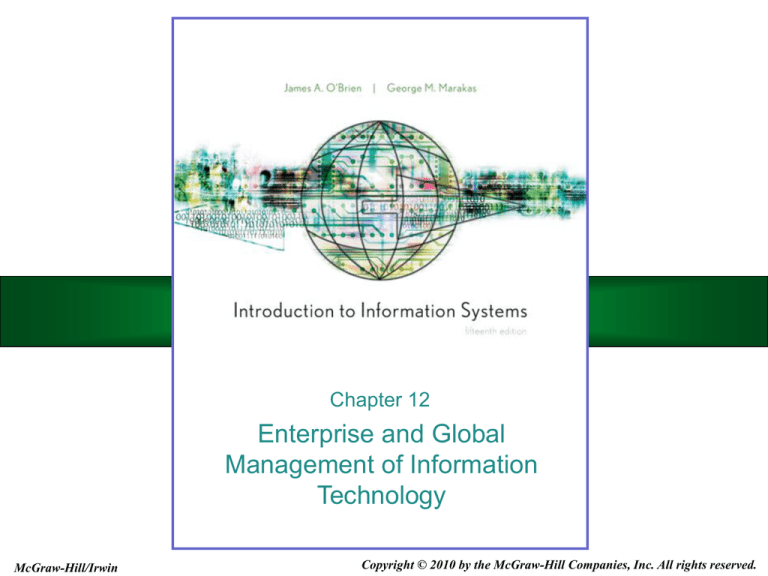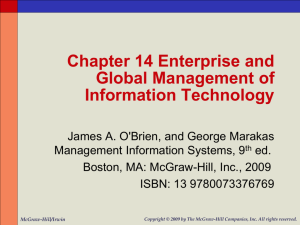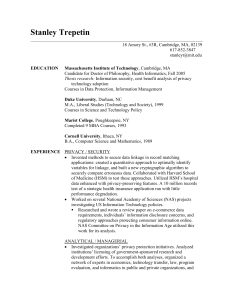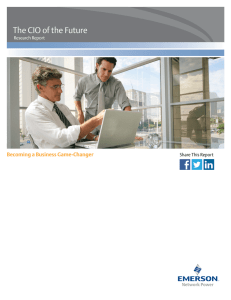
Chapter 12
Enterprise and Global
Management of Information
Technology
McGraw-Hill/Irwin
Copyright © 2010 by the McGraw-Hill Companies, Inc. All rights reserved.
Learning Objectives
Identify the three components of
information technology management
– Use examples to illustrate how they might
be implemented in a business
Explain how failures in IT management can
be reduced by the involvement of business
managers in IT planning and management
12-2
Learning Objectives
Identify several cultural, political, and geoeconomic challenges that confront managers
in the management of global information
technologies
Explain how the trend toward a transnational
business strategy by international business
organizations affects global business/IT
strategy
12-3
Learning Objectives
Identify several considerations that affect the
choice of IT applications, IT platforms, data
access policies, and systems development
methods by a global business enterprise
Understand the fundamental concepts of
outsourcing and offshoring, as well as the
primary reasons for selecting such an
approach to IS/IT management
12-4
Business and IT
As the 21st century unfolds, many companies are
transforming themselves into global powerhouses
via major investments in…
Global e-business
E-commerce
Other IT initiatives
Business managers and professionals must know
how to manage this vital organizational function
12-5
Case 1: Toyota, Procter & Gamble, Hess Corp…
The role of a CIO has become very strategic
– Tomorrow’s CIOs will be even more involved
in strategic thinking and influential
– Skills needed to be a CIO have changed from
being a technologist to business strategist
Developing and mentoring successors is
a key responsibility of IT leaders in an
environment that includes the changing
role of the CIO and a shortage of qualified
managers
12-6
Case Study Questions
Several comments in the case note that CIOs
are in a unique position for companywide
leadership, extending beyond their primary
technological concerns
– Why do you think this is the case?
– How are CIOs different in this regard from
other chief officers, for example, in finance,
HR, or marketing?
12-7
Case Study Questions
After reading the case, what do you think are
the most important competencies for the
successful CIO of tomorrow?
– How do you rate yourself in those?
– Had you considered the importance of these
skills and abilities before?
12-8
Case Study Questions
How can CIOs prepare their successors for
an uncertain future that will most likely
require skills different from those possessed
by successful CIOs today?
– Which key competencies are enduring,
and which are a function of the current
technological environment?
– How can CIOs prepare for the latter?
12-9
Components of IT Management
12-10
The Business/IT Planning Process
12-11
The Business/IT Planning Process
Major components of business/IT planning
Strategic
development
Resource
management
Technology
architecture
12-12
Information Technology Architecture
The IT
architecture is
a conceptual
design that
includes these
major
components
Technology platform
Data resources
Application architecture
IT organization
12-13
Managing the IT Function
Three things recently happened
The Internet boom inspired businesses
to connect their networks
Companies have essential applications on their
intranets, without which they cannot function
It became apparent that maintaining PCs
on a network is very, very expensive
Created an urgent need for centralization
12-14
Organizing IT
Early Years
Centralization
of computing
with large
mainframes
Next
Current
Downsizing and
moving back to
decentralization
Centralized
control over the
mgmt of IT
Serving the
strategic needs
of business
units
Hybrid of
centralized and
decentralized
components
12-15
Avnet Marshall Organizational Components
12-16
Managing Application Development
Systems
analysis
& design
System
maintenance
Prototyping
Application
development
involves…
Applications
programming
Quality
assurance
Project
management
12-17
Managing IS Operations
IS operations management
– Concerned with the use of hardware, software,
network, and personnel resources in data
centers
Operational activities that must be managed
– Computer system operations
– Network management
– Production control
– Production support
12-18
System Performance Monitors
Software packages that…
Optimize
computer system
performance
Monitor
computer job
processing
Facilitate
capacity planning
and control
12-19
Features of System Performance Monitors
Chargeback
Systems
Process Control
Capabilities
Allocates costs to
users based on
the information
service rendered
Systems that
monitor and
automatically
control computer
operations at large
data centers
12-20
IT Staff Planning
Recruiting, training,
and retaining
qualified IS personnel
Evaluating employees
and rewarding good job
performance with salary
increases, promotions
Setting salary
and wage levels
Designing
career paths
12-21
IT Executives
Chief Information
Officer (CIO)
Oversees all uses of IT
Aligns IT with strategic
business goals
In charge of all IT
planning/deployment
Chief Technology
Officer (CTO)
Manages the IT platform
Second in command
12-22
Other IT Positions
E-commerce
architect
Technical
team leader
Systems
analyst
Chief
Security Officer
12-23
Technology Management
All IT technologies must be used as a
technology platform for integrating business
applications
– Both internally or externally focused
– Includes Internet, intranets, electronic
commerce, collaboration technologies, CRM
software, enterprise resource planning, and
supply chain management
Often the primary responsibility of a chief
technology officer
12-24
Managing User Services
Business units that support and manage
end-user and workgroup computing
– Can be done with information centers
staffed with user liaison specialists or with
Web-enabled intranet help desks
Key roles
– Troubleshooting problems
– Gathering and communicating information
– Coordinating educational efforts
– Helping with end-user application development
12-25
Outsourcing
The purchase of goods or services
from third-party partners
that were previously provided internally
12-26
Why Companies Outsource
12-27
Offshoring
Relocation of an organization’s business processes
to a lower-cost location
This location is typically overseas
Can be either production or service
Growth of services offshoring linked to…
Digitization of many services
Availability of large amounts of reliable and
affordable communication infrastructure
12-28
Failures in IT Management
IT not used
effectively
Computerizing traditional business
processes instead of developing
innovative e-business processes
Poor response times
Frequent downtime
IT not used
efficiently
Poorly managed application
development
12-29
Management Involvement & Governance
Managerial and end user involvement
– Key ingredient to high-quality information
system performance
– Optimizes business value of IT
Governance structures
– Steering committees, executive councils
– Encourages active participation in planning
and controlling business uses of IT
– Helps avoid post-development problems
12-30
Sr. Management’s Involvement in IT
12-31
IT Governance Approaches
Control Objectives for Information and
Technology (COBIT)
– Framework for IT management
– Set of generally accepted measures,
indicators, processes, and best practices
Covers four domains
– Planning and organization
– Acquisition and implementation
– Delivery and support
– Monitoring
12-32
COBIT in Action
12-33
The International Dimension
Companies around the world are developing new
models to operate competitively in a digital economy
These models are
structured, yet agile,
global, yet local
Concentrates on
maximizing risk-adjusted
return from both knowledge
and technology assets
12-34
Case 2: Reinsurance Group of America, Fronterrra
Consistency across the different business functions,
countries, languages, and processes in worldwide
implementations is one of the most important challenges
faced by global organizations today
Reinsurance Group of America had to develop a single
system to manage reinsurance business processes for
numerous offices around the world
– Staffs spoke different languages, in different time
zones, and some were set in their way of managing
the business
Developing this system resulted in ROI of 15%, which
was better than expected
12-35
Case Study Questions
What is the business value of these global
system developments for the companies
mentioned in the case?
– How did they achieve these benefits?
– What were the major obstacles they had to
overcome?
What are the advantages and disadvantages
of a full-blown versus a phased approach for
system implementations in general, and
global ones in particular?
– How do you decide which road to take?
12-36
Case Study Questions
How important is that all units in global
organization speak the same business
language, and use the same functions
and business processes?
– How do you balance the competing
needs for flexibility and consistency
across operations?
12-37
Global IT Management Dimensions
12-38
Global IT Management Challenges
Political Challenges
Many countries regulate or prohibit the
transfer of data across their national boundaries
Others severely restrict, tax, or prohibit
imports of hardware and software
Some have local content laws that specify the portion of
the value of a product that must be added in that country
if it is to be sold there
Others require a business to spend part of the revenue
they earn in a country in that nation’s economy
12-39
Global IT Management Challenges
Geo-economic Challenges
Physical distances still a major problem
Takes too long to fly in specialists
Hard to communicate in real time across time zones
Poor telephone and telecommunications services
May be hard to find skilled local workers
Differences in the cost of living and labor costs
12-40
Global IT Management Challenges
Cultural Challenges
Language and cultural interests
Religions and customs
Political philosophies
Cultural training needed before assignments
Work styles and business relationships
12-41
Transnational Strategies
Companies are moving toward
a transnational strategy
Business depends heavily on information
systems and Internet technologies to help
integrate global business activities
This requires an integrated and
cooperative worldwide IT platform
12-42
Transnational Business/IT Strategies
12-43
Global Business Drivers
Business requirements caused by the nature
of the industry and its competitive or
environmental forces
Examples of global drivers
– Customers
– Products
– Operations
– Resources
– Collaboration
12-44
Global IT Platforms
Hardware Difficulties
High prices
High tariffs
Import
restrictions
Long lead
times for
government
approvals
No local
service or
spare parts
Lack of
“localized”
documentation
12-45
Global IT Platforms
Software Difficulties
Packages developed in
Europe may be
incompatible with
American or Asian
versions
Software publisher may
refuse to supply markets
that disregard software
licensing and copyright
agreements
12-46
International Data Communications Issues
12-47
The Internet as a Global IT Platform
The Internet
An interconnected matrix that reaches tens
of millions of users in over 100 countries
Business environment free of
traditional boundaries and limits
Without incurring massive cost outlays for
telecommunications, companies can…
Expand markets
Reduce communications and distribution costs
Improve profit margins
12-48
Key Questions for Global Websites
Will you have to develop a new navigational
logic to accommodate cultural preferences?
What content will you translate, and what
content will you create from scratch to address
regional competitors or products that differ
from those in the U.S.?
Should your multilingual effort be an adjunct
to your main site, or will you make it a separate
site, perhaps with a country-specific domain?
12-49
Key Questions for Global Websites
What kinds of traditional and new media
advertising will you have to do in each country to
draw traffic to your site?
Will your site get so many hits that you’ll need to
set up a server in a local country?
What are the legal ramifications of having your
website targeted at a particular country, such as
laws on competitive behavior, treatment of
children, or privacy?
12-50
Internet Users by World Region
12-51
Global Data Access Issues
Transborder Data Flows may be seen as violating
A nation’s sovereignty because it avoids
customs duties and regulations
Laws protecting the local
IT industry from competition
Laws protecting local jobs
Privacy legislation
12-52
U.S.-E.U. Data Privacy Requirements
Key Data Privacy Provisions
Notice of purpose and
use of data collected
Ability to opt out of thirdparty distribution of data
Access for consumers
to their information
Adequate security, data
integrity, and
enforcement provisions
12-53
Internet Access in Restrictive Countries
The struggle between Internet censorship
and openness at the national level relates to
– Controlling the conduits
– Filtering the flows
– Punishing the purveyors
Most of the world has decided that restricting
Internet access is not a viable policy
– Restricting access also hurts a country’s
opportunities for economic growth and
prosperity
12-54
Global Government Internet Restrictions
High Government Access Fees
– Kazakhstan, Kyrgyzstan
Government Monitored Access
– China, Iran, Saudi Arabia, Azerbaijan,
Uzbekistan
Government Filtered Access
– Belarus, Cuba, Iraq, Tunisia, Sierra Leone,
Tajikistan, Turkmenistan, Vietnam
No Public Access Allowed
– Burma, Libya, North Korea
12-55
Global Systems Development
Key Development Issues
Local versus global system requirements
Getting agreement on system features
Global standardization of data definitions
Disturbances caused by systems
implementation and maintenance activities
12-56
Global Systems Development
Key development strategies
– Transform an application used by the home
office or a subsidiary into a global application
– Set up a multinational development team
– Parallel development
– Centers of excellence
– Offshore development
12-57
Internet-Enabled IT Development
12-58
Case 3: IBM Corporation
Only services can provide growth on the scale
that IBM needs to make shareholders happy
– To combat cheaper offshore companies, IBM
is giving away technology
In theory, giving away software, patents, and
ideas will
– Help the entire industry grow faster
– Open new frontiers
– Create opportunities for IBM to sell high-value
products and services
12-59
Case 4: IBM Corporation
To cut costs, IBM is also offshoring
– India accounts for the largest number of
IBMers outside the United States
By the end of next year, IBM Services head
count in India will top 52,000
– More than one-fourth of all services personnel
– About one-sixth of IBMers worldwide
12-60
Case Study Questions
Do you agree with IBM’s employment
response to competition from software
development contractors in India like Wipro
that are expanding into IT consulting
services?
Will IBM’s plan to give away some of its IT
assets and intellectual property and increase
support of opensource software products be
a successful growth strategy in the “brutally
competitive marketplace” in which it
operates?
12-61
Case Study Questions
Do you agree with IBM researchers’
assumption that IT will remain “hard to use,
expensive, and labor-intensive, with
customers continuing to need help solving
business problems” for along time to come?
– Should IBM bet its business on that
assumption?
12-62







